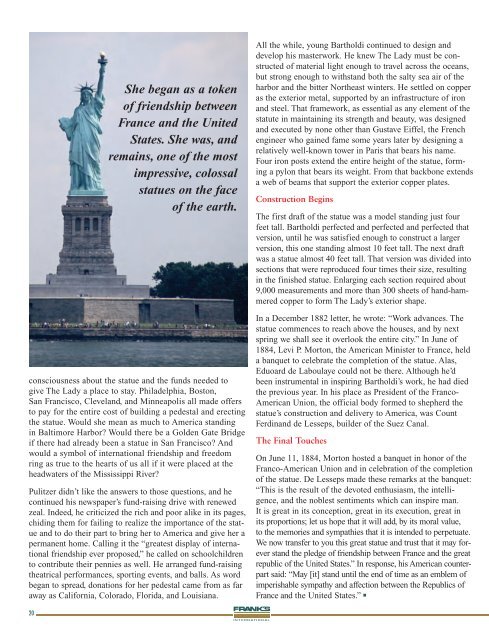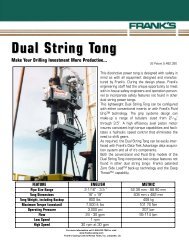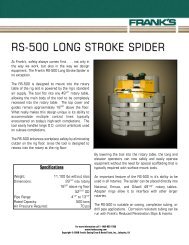Master Mag Templet - Frank's International, Inc.
Master Mag Templet - Frank's International, Inc.
Master Mag Templet - Frank's International, Inc.
Create successful ePaper yourself
Turn your PDF publications into a flip-book with our unique Google optimized e-Paper software.
consciousness about the statue and the funds needed to<br />
give The Lady a place to stay. Philadelphia, Boston,<br />
San Francisco, Cleveland, and Minneapolis all made offers<br />
to pay for the entire cost of building a pedestal and erecting<br />
the statue. Would she mean as much to America standing<br />
in Baltimore Harbor? Would there be a Golden Gate Bridge<br />
if there had already been a statue in San Francisco? And<br />
would a symbol of international friendship and freedom<br />
ring as true to the hearts of us all if it were placed at the<br />
headwaters of the Mississippi River?<br />
Pulitzer didn’t like the answers to those questions, and he<br />
continued his newspaper’s fund-raising drive with renewed<br />
zeal. Indeed, he criticized the rich and poor alike in its pages,<br />
chiding them for failing to realize the importance of the statue<br />
and to do their part to bring her to America and give her a<br />
permanent home. Calling it the “greatest display of international<br />
friendship ever proposed,” he called on schoolchildren<br />
to contribute their pennies as well. He arranged fund-raising<br />
theatrical performances, sporting events, and balls. As word<br />
began to spread, donations for her pedestal came from as far<br />
away as California, Colorado, Florida, and Louisiana.<br />
20<br />
She began as a token<br />
of friendship between<br />
France and the United<br />
States. She was, and<br />
remains, one of the most<br />
impressive, colossal<br />
statues on the face<br />
of the earth.<br />
All the while, young Bartholdi continued to design and<br />
develop his masterwork. He knew The Lady must be constructed<br />
of material light enough to travel across the oceans,<br />
but strong enough to withstand both the salty sea air of the<br />
harbor and the bitter Northeast winters. He settled on copper<br />
as the exterior metal, supported by an infrastructure of iron<br />
and steel. That framework, as essential as any element of the<br />
statute in maintaining its strength and beauty, was designed<br />
and executed by none other than Gustave Eiffel, the French<br />
engineer who gained fame some years later by designing a<br />
relatively well-known tower in Paris that bears his name.<br />
Four iron posts extend the entire height of the statue, forming<br />
a pylon that bears its weight. From that backbone extends<br />
a web of beams that support the exterior copper plates.<br />
Construction Begins<br />
The first draft of the statue was a model standing just four<br />
feet tall. Bartholdi perfected and perfected and perfected that<br />
version, until he was satisfied enough to construct a larger<br />
version, this one standing almost 10 feet tall. The next draft<br />
was a statue almost 40 feet tall. That version was divided into<br />
sections that were reproduced four times their size, resulting<br />
in the finished statue. Enlarging each section required about<br />
9,000 measurements and more than 300 sheets of hand-hammered<br />
copper to form The Lady’s exterior shape.<br />
In a December 1882 letter, he wrote: “Work advances. The<br />
statue commences to reach above the houses, and by next<br />
spring we shall see it overlook the entire city.” In June of<br />
1884, Levi P. Morton, the American Minister to France, held<br />
a banquet to celebrate the completion of the statue. Alas,<br />
Eduoard de Laboulaye could not be there. Although he’d<br />
been instrumental in inspiring Bartholdi’s work, he had died<br />
the previous year. In his place as President of the Franco-<br />
American Union, the official body formed to shepherd the<br />
statue’s construction and delivery to America, was Count<br />
Ferdinand de Lesseps, builder of the Suez Canal.<br />
The Final Touches<br />
On June 11, 1884, Morton hosted a banquet in honor of the<br />
Franco-American Union and in celebration of the completion<br />
of the statue. De Lesseps made these remarks at the banquet:<br />
“This is the result of the devoted enthusiasm, the intelligence,<br />
and the noblest sentiments which can inspire man.<br />
It is great in its conception, great in its execution, great in<br />
its proportions; let us hope that it will add, by its moral value,<br />
to the memories and sympathies that it is intended to perpetuate.<br />
We now transfer to you this great statue and trust that it may forever<br />
stand the pledge of friendship between France and the great<br />
republic of the United States.” In response, his American counterpart<br />
said: “May [it] stand until the end of time as an emblem of<br />
imperishable sympathy and affection between the Republics of<br />
France and the United States.” ■

















